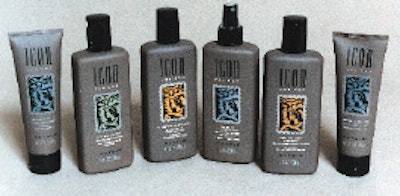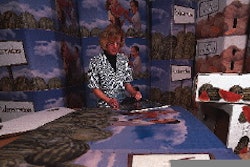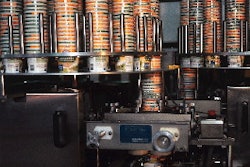Last year wasn't exactly a banner year for the use of new materials in the packaging business. Except maybe for the identification of the first few applications of metallocene polyethylenes. So it was more than surprising that a packaging competition not renowned for the use of new materials should select a line of packages that exhibited a sizable risk to its user, Matrix Essentials, a Bristol-Myers Squibb subsidiary from Solon, OH. The competition was that of the National Assn. of Container Distributors, and the new material was Montell's (Wilmington, DE) Adflex(TM) polyolefin copolymer. While Matrix won the Bernard Seid Best of Show award, the competition also honored gold, silver and bronze winners in each of seven categories. They're described in coverage accompanying this article. The three awards in the cosmetics/personal care category are described separately (see page 70). All awards were presented April 12 at the NACD annual meeting, held at the Maui Hyatt Regency Hotel in Hawaii. Packaging awards are not foreign to Matrix Essentials. It won the very same NACD Best of Show award three years ago for its Biolage line of women's cosmetics. This year, the award went to its Icon line of men's haircare products in both bottles and tubes, provided through the services of Kaufman Container (Cleveland, OH). Each package form used a coextrusion of high-density polyethylene with the Montell rubberized polypropylene to create containers with an unusual, "suede-like" feel to them. Two 8-oz bottles (only the finish is different) and a tube make up the shapes for the product line that's exclusively sold through hair salons. * For Silgan Plastics (Chesterfield, MO), the two bottles required the use of three-layer coextrusion technology. Each bottle has a core layer of 25% post-consumer recycled HDPE with an inner layer of virgin HDPE and an outer skin layer of Adflex. Silgan's Ligonier, IN, plant molds both bottles from the same set of eight-cavity molds. Neck inserts are used to distinguish between the bottles that are topped with a Euromist spray head from Seaquist (Mukwonago, WI) or a flip-top dispensing head from Rexam (Evansville, IN). The bottles are later screen-printed by Kaufman. * Tubed Products' (Easthampton, MA) structure was simpler. The 4-oz tubes it makes for the Icon line are a two-layer coextrusion of HDPE and Adflex. The use of the rubberized polyolefin eliminates a conventional barrier coating to the tube. So the supplier extensively tested the tubes with the various products to determine product/package compatibility and ink adhesion. Tubed Products dry-offset prints the tubes in four colors. Eventually, they're topped with butterfly flip-top caps from either Zeller Plastik (Libertyville, IL) or Seaquist. Custom blow molds "We wanted to come out with something that looked totally different from the rest of our products," says John Kreft, manager of packaging engineering for Matrix. "Since these were for men only, we wanted a different shape, something more masculine. But we didn't want anything too intricate or fancy. We looked for something simple that our packaging lines could handle." After it evaluated a wide variety of containers, Matrix decided to build its own molds for the bottles. So, with Kaufman's help, an 8-oz bottle-what Kreft calls a "basic square"-mold was created by Silgan. About this time, the company was introduced to Montell's Adflex by Therese Melick, an account manager from Kaufman, and Silgan produced sample bottles using Adflex with some existing molds it had. "I think our marketing people just liked the feel of the resin," Kreft says. "They felt it had a 'suede' feel to it, which has a masculine connotation. But there were a lot of 'ifs' along with it." Silgan and Tubed Products had done only some very modest experimental work with the Adflex resin. And in the cosmetics area, Kreft says no company had used it commercially yet. So the "ifs" included: Could Silgan use it on the Matrix bottle? Could Silgan maintain the color Matrix wanted? Would it be be too costly to process? Kreft knew early on how susceptible the material was to scuffing, so he questioned what that would mean for decorating, filling and shipping. Tests confirmed vulnerability Once a color was chosen, Matrix put the bottles through scuff testing, and Kaufman tested them with its screen printing process. "Everything looked good from the tests, but we realized that the bottle was very susceptible to scuffing if it wasn't handled carefully," says Kreft. About the same time, Matrix contacted Tubed Products about using the same material. Although it could produce two-layer coextruded tubes, Tubed Products also had questions about the material. "We can say that you can't use a simple general-purpose HDPE resin with the rubberized polypropylene," says Jim Farley, manager of new product development for Tubed Products. "We don't want to be any more specific than that. The Montell people helped us to learn what resins we'd need to use the Adflex successfully. John Martinek is our polymer engineer and he did the R&D on the resins." The company's sophisticated sample processing lab helped Tubed Products to match the color that had been selected for the bottles. Martinek did say that Adflex is a bit tricky to process, and it does slow down the extrusion process. It's likely that Silgan had the same experience, although Packaging World was unable to reach Silgan's development engineers. Special handling The good news is that both Tubed Products and Kaufman confirm that the Adflex does print very well, whether using dry offset on the tube or screen printing four colors front and one color back on the bottles. However, testing revealed that Silgan and Kaufman would have to modify bottle packing to avoid scuffing. Each company hand-packs the bottles layer-by-layer into what Kreft calls bulk boxes. At the Matrix plant, special handling continues. For one thing, the Icon bottles are filled on a medium-speed line with an intermittent-type filler. And line monitoring needs to be increased. "We watch the unscrambler more carefully now, and you have to be careful of any possible jams on the line," Kreft reports. "They're just not as forgiving as regular bottles." The bottles have to be hand-packed into a more costly shipper. "We use a 12-cell divider that's wax coated to help avoid scuffing. Plus, to immobilize the bottles so they don't move in the box, we size the shipper a bit smaller so there's almost no chance for the bottles to move, even when we ship across the country." Although this works well for regular shipments, it makes it difficult to pack the inevitable promotional packs that include sample bottles of another product. Because of the fragile bottle surface, Matrix expected it would have to absorb the costs of a high rate of returned merchandise. Not so, states Kreft. "I thought we'd have a high incidence of returns with these bottles, because scuffing makes them all but unsalable. But that hasn't happened. In fact, the only problem we experience in shipping is more corrugated dust in the box. So we recommend that our customers wipe off the bottles before they put them on display." Strong reaction The line was introduced last summer, and shipments began in late August. But the packaging project had begun in the spring, so Kaufman, Silgan and Tubed Products had just a few months to go from resin testing to shipping of finished containers. However, as Farley of Tubed Products points out, "Tight timetables are not unusual in the market today. So that wasn't a particular problem for us." The reaction from the salons that Matrix sells through has been unexpected. "The line has sold considerably better than we expected," Kreft reports. "Men's haircare products are a tough market, but our reorders have been much better than we planned. In fact, it's gone so well, we're planning to add more products to the line this year." The Icon bottles retail for about $8; the tubes for $6. In fact, Kaufman is now installing a new screen printing system that will permit four color printing in a single pass. "That means we'll be able to decorate this bottle in two passes, one for the four-color front, one pass for the back," Kaufman's Melick says. "We hope we can reduce the cost to Matrix a bit, while it also should help reduce scuffing." Kaufman currently does three passes: two colors applied and cured, two more colors applied and cured and a one- color pass. That, she says, will help Kaufman keep up with the volume of bottles coming from the blow molder.


























